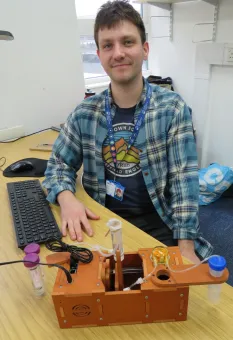
Scientists from the National Oceanography Centre (NOC) and Stanford University are today (11 March) hosting a special assembly to launch the Monitoring Anthropogenic Particles and Plankton using citizen Science (MAPPS) project to increase understanding of the UK’s plankton communities and the spread of microplastics.
The NOC’s B.B. Cael, Alice Horton, Elena Garcia-Martin and Will Major are collaborating with Thibaut Pollina, Adam Larson, and Manu Prakash from Stanford University and Colomban de Vargas from CNRS to lead citizen scientists and staff from 19 Wildlife Trusts to collect a vital data set over the course of at least a year.
Microplastics are of emerging global concern, due to their potential to cause harm across eco systems, but more data is needed about their spread in the ocean, and their interaction with plankton – a food source for many aquatic organisms. In order to fill this data gap, the MAPPS project will enable citizen scientists to generate the microplastic and plankton time-series using a PlanktoScope. The PlanktoScope, a low-cost flow imaging microscope, is composed of a Rapsberry Pi computer and a camera, two lenses for magnification and a flow system. The flow system affords efficient imaging of microscopic particles in a water sample as they proceed past the camera.
Another of the project’s objectives is to create and validate the first classifier for anthropogenic (synthetically produced) particles, especially microplastics, meaning images of fibres and small plastic debris can be automatically categorised as anthropogenic. Microplastics are known to be abundant throughout aquatic systems, but little research has yet been done in this area on UK rivers and coasts. This will therefore give a preliminary indication of the contamination of various UK aquatic habitats with these potentially harmful particles, in habitats where zooplankton are abundant.
Funding from the Natural Environment Research Council (NERC) and a grant from the Royal Society will enable national-scale sampling to collect the microplastic and plankton data, which will be openly accessible online. MAPPS will therefore ensure an effective transfer of knowledge from the scientific community to the general public on the importance of plankton in biogeochemistry, and in the environmental health, generating engagement and providing a unique learning experience.
During today’s assembly, NOC scientists will help the citizen scientists to build and mount the PlanktoScope, and train them to use the device. The training provided will enable volunteers to be self-sufficient in the generation of data during the coming months.
Lissa Batey, Head of Marine Conservation, The Wildlife Trusts said: “Wildlife Trusts all over the country, at coastal locations and inland on our waterways are preparing to construct PlanktoScope to take a closer look at the animals and plants that lie hidden from the naked eye in our waters. We are excited about the opportunities that having these specialised microscopes will bring.
We hope to raise awareness of these tiny life forms and use the PlanktoScope to give us the ability to monitor long term and help us address conservation questions about the health of our waters, both fresh and salty. The adventure awaits!”
The NOC’s Elena García-Martín said: “Collecting this kind of data for monitoring purposes is very labour-intensive and expensive. In MAPPS, we combine low cost equipment, citizen scientists and scientific expertise which is an excellent way to improve the spatial and temporal resolution of sampling aquatic environments”